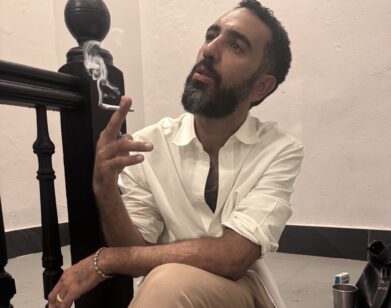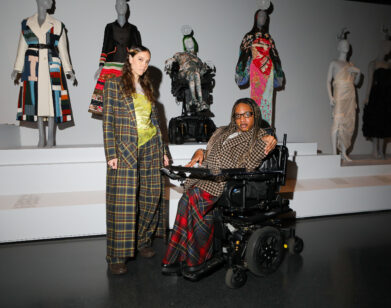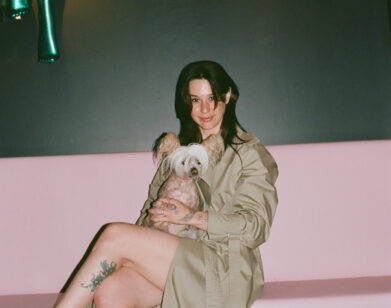art
Kayode Ojo Lets You Call His Latest Exhibition What You Want

Kayode Ojo, Without trousers (Suitmeister), 2021, Suitmeister – Sequins Blazer Silver – Disco Glitter Party Blazer for Men – Christmas Mardi Gras Halloween Costume Party Silver Blazer- Size L, carabiner hooks with key fob 25 mm (silver), Hamilton Stands KB400 Classic American Folding Sheet Music Stand (Chrome), StarSide Crystal Chandelier Teardrop Prisms 50mm, 53 1/2 x 16 7/8 x 16 7/8 inches.
Installation view: Kayode Ojo, Call it what you want, Sweetwater, Berlin. April 30 – June 19, 2021. Courtesy of Kayode Ojo and Sweetwater, Berlin.
The New York-based artist Kayode Ojo gathers readymade materials such as chandeliers, evening gowns, chains, faux crystal, sheet music stands, and acrylic beaded door curtains in his installations that reference fashion and consumer culture. The objects are often placed atop mirrored or chrome pedestals like those in luxury department stores windows, with which they share the allure of aspiration. His usage of countterfeit materials that look like their authentic counterparts reflect society’s fixation on self-representation, class aspirations and the anxieties inherent to aesthetic choices. In recent years, Ojo has had exhibitions at Martos Gallery in New York, PrazDelavallade in Los Angeles, and Balice Hertling in Paris. We caught up with him before the opening of his solo exhibition at Sweetwater Gallery in Berlin.
———
LOUIS-PHILIPPE VAN EECKHOUTTE: The title of your upcoming exhibition is Call it what you want. Does it refer to the Taylor Swift song?
KAYODE OJO: It’s also a song by Foster the People. We had long conversations here in Berlin about music and about electroclash and about this period of time of bedroom rock. I remember that it’s also a song by Taylor Swift. I made a lot of work about Taylor Swift. She is from Pennsylvania, but she plays off that she’s kind of from the South. I think she went to Belmont, the music business university. It’s an hour away from where I grew up.
VAN EECKHOUTTE: You grew up in Tennessee?
OJO: Yes. Born and raised. Call it what you want is a strange title for an exhibition. I did a show once and the hosts didn’t ask me about the title, I just saw a poster and they had just called it what they wanted.
VAN EECKHOUTTE: What shifts within the work will people see between this exhibition and previous solos?
OJO: This one is not directly based on a film and there has been a shift towards masculinity.

Kayode Ojo, Flyover state, 2021, Amazing Hasselblad 500cm Camera Suitcase Case Briefcase 26″x 18.75″x 5.75″, Clear Amac Boxes (8), Mirrors, 35 3/8 x 26 x 26 inches.
Installation view: Kayode Ojo, Call it what you want, Sweetwater, Berlin. April 30 – June 19, 2021. Courtesy of Kayode Ojo and Sweetwater, Berlin.
VAN EECKHOUTTE: Does the work mostly happen in the studio or during install at the gallery?
OJO: I make pictures called closed audition, so the work is audition somewhere. It is photographed in many different ways. It starts as an audition. Then it actually becomes closer to a performance by the time that happens, because at some point, I have to go in there, unless I could teach someone how to do it. It happens on site. I used to tell people that’s basically very similar to making a sandcastle, but that they’re permanent now. I go on site and I have to be in the space. It’s very important to me to actually look at the space because it’s so much of it is attached to the architecture.
VAN EECKHOUTTE: How do you know when something is cast and becomes part of the work?
OJO: I know when I arrive on set.
VAN EECKHOUTTE: Where do you source the materials for your works?
OJO: Wherever they are.
VAN EECKHOUTTE: Mostly online or also in boutiques?
OJO: It’s a mix. A lot is online. When you see the descriptions of the titles, if I got it online, it tells you exactly how they described it. That’s why you have all the different keywords. Because the key thing is, that’s how they make you find stuff online. Things like a prom dress, party mix… When I used to work for a gallery, one of my tasks was to find images and label every aspect of them. If I took a picture of you right now, I would say: books, curtains, glasses, sweater, camel, young, man.
VAN EECKHOUTTE: Haim Steinbach once said that the artist-shopper must take on, simultaneously, the perspective of the general consumer to whom the commodity is marketed and that of the more detached critic. Is that also your approach when you’re sourcing your materials?
OJO: There is nothing else to do, right? If I see a dress that I want, I can’t buy it differently just because I’m an artist. I have to get the size that I want, and I have to wait, and I have to fight with anyone else that wants to buy it. You can’t separate yourself. When you buy these goods, there can’t be really a difference. Because I can’t tell them that I need it for a different reason.

Kayode Ojo, Vaterdrum, Mutterdrum, Michdrum, 2021, SONGMICS Heavy Duty Clothes Rack Coat Rack on Wheels (2), Floor Standing Sign Holder – Single Tier Chrome, Pearl CRB524P C730 Crystal Beat Fusion Shell Drum Set Acrylic, Liberty Imports Heavy Duty Diecast Metal Stainless Steel Handcuffs with Keys Bulk Party Favors for Police Kids Role Play (6), The Glass Cage by Georges Simenon, Installation dimensions variable.
Installation view: Kayode Ojo, Call it what you want, Sweetwater, Berlin. April 30 – June 19, 2021. Courtesy of Kayode Ojo and Sweetwater, Berlin.
VAN EECKHOUTTE: What’s the place of photography within your work and your process?
OJO: I’m a photographer. I’ve always been one. The school I went to was very intense. The photographs I make now may be a relationship to a certain amateur style of doing it. But what do they say? You need to know the rules before you can break the rules. I had a professor once that made us use mathematical equations. At first, we always needed to think about what mathematical equation we needed if, for example, you wanted to photograph a naval ship and to have the entire thing in focus.
VAN EECKHOUTTE: Reflection and mirroring are repeated motifs in your work.
OJO: My birth sign is Gemini.
VAN EECKHOUTTE: There’s a particular kind of glamour and seduction reflected throughout your work that reminds me of the aesthetics of ’80s luxury and the set design of Dynasty.
OJO: I have seen Dynasty. There’s the show called Dynasty and the show called Dallas. Josephine Meckseper made a video that combined the two. It was called “DDYANLALSATSY.” One of the things I love about art is that I get to learn things about culture. Back when I was young, I would go back to Tennessee for the summer and there would be this forever time where nothing happened. I watched the entire series. Dallas was set in Dallas, obviously, and Dynasty in Colorado, and they were both about oil. I’m pretty sure that I’ve watched the entire season of the one that has Joan Collins in it.
VAN EECKHOUTTE: You often seek out inexpensive objects that look like their high-end counterparts. What is the relationship between these and the ideas of the real and the authentic?
OJO: There’s actually no difference. I do understand that certain brands actually make things that would last longer, but because it’s fashion, you won’t even wear it longer. I guess I have a question: why do people buy real diamonds?
VAN EECKHOUTTE: Maybe for the fetish of the price?
OJO: Some people like to spend money. I’m not exactly sure what they get out of it. I know a girl that used to be a financial dominatrix and guys would pay her to spend their money.

Kayode Ojo, I put all of my energy into this tower, 2021, Kiev 88, Alco 8601 Letterbox 31 x 36 x 15 cm Varnished Silver (5), Mirrors, Five parts, each: 12 1/4 x 14 1/8 x 13 3/4 inches.
Installation view: Kayode Ojo, Call it what you want, Sweetwater, Berlin. April 30 – June 19, 2021. Courtesy of Kayode Ojo and Sweetwater, Berlin.
VAN EECKHOUTTE: I saw that you had the book The Power Look at Home: Decorating for Men by Egon von Fürstenberg in your studio.
OJO: That book is about the idea of a bachelor pad and architecture for men. It’s just pictures of guys with their houses, cameras, stereos, liquor. I guess it’s just a place that you bring women. I thought it was really interesting. People are talking about Hugh Hefner right now. Then there’s also that essay about the horizontal studio. It connects back to my interest in architecture and the spaces in which my works are installed.






